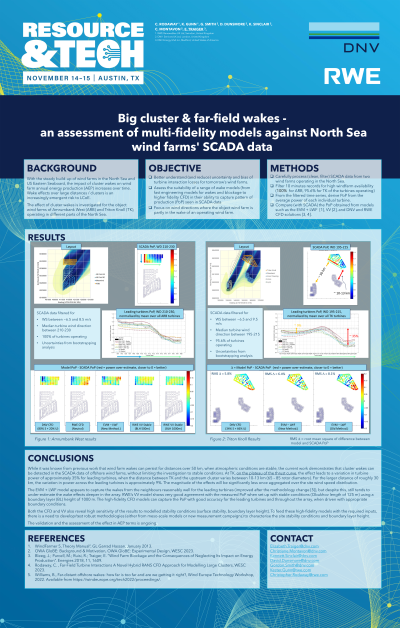Back

Wind: Wakes & Losses
Big cluster & far-field wakes, an assessment of multi-fidelity models against North Sea wind farms SCADA data
Tuesday, November 14, 2023
4:15pm – 5:15pm CST


Elizabeth A. Traiger, Ph.D, M.Sc, B.S.
Senior Consultant
DNV, Utah
Presenter(s)
Presentation Description: With the steady build-up of wind farms in the North Sea and US Eastern Seaboard, the impact of cluster wakes on wind farm annual energy production (AEP) increases over time. Wake effects over large distances and wake clusters are an increasingly emergent risk to LCoE.
The modeling uncertainty and potential for bias around this impact is large since most models to calculate turbine interaction losses have to date been validated for smaller rotors/wind farms than those currently in development and planned for the future.
As part of their ongoing efforts to produce accurate AEP assessments, DNV and RWE have teamed up to compare a range of wake models (from fast engineering models for wakes and blockage to higher fidelity CFD) in their ability to capture the pattern of production seen in SCADA data with a focus on neighboring wind farm signals.
The analysis looks at internal and near-/far-field external wake effects, from wind farms in the North Sea, as a function of atmospheric stability and boundary layer height. The current contribution focuses on cluster-to-cluster impacts, for cluster distances of up to 35 km and confirms earlier findings that cluster wakes are clearly visible in SCADA data up to these distances. The assessment of the effect in AEP terms is ongoing.
The modeling uncertainty and potential for bias around this impact is large since most models to calculate turbine interaction losses have to date been validated for smaller rotors/wind farms than those currently in development and planned for the future.
As part of their ongoing efforts to produce accurate AEP assessments, DNV and RWE have teamed up to compare a range of wake models (from fast engineering models for wakes and blockage to higher fidelity CFD) in their ability to capture the pattern of production seen in SCADA data with a focus on neighboring wind farm signals.
The analysis looks at internal and near-/far-field external wake effects, from wind farms in the North Sea, as a function of atmospheric stability and boundary layer height. The current contribution focuses on cluster-to-cluster impacts, for cluster distances of up to 35 km and confirms earlier findings that cluster wakes are clearly visible in SCADA data up to these distances. The assessment of the effect in AEP terms is ongoing.
Learning Objectives:
- understand through the observed SCADA data analysis the realized impacts of cluster wakes on operational wind farms.
- understand the gap between production modeled by a variety of commercial wake models, including engineering and high-fidelity, and the actual realized production at an operational wind power project.

